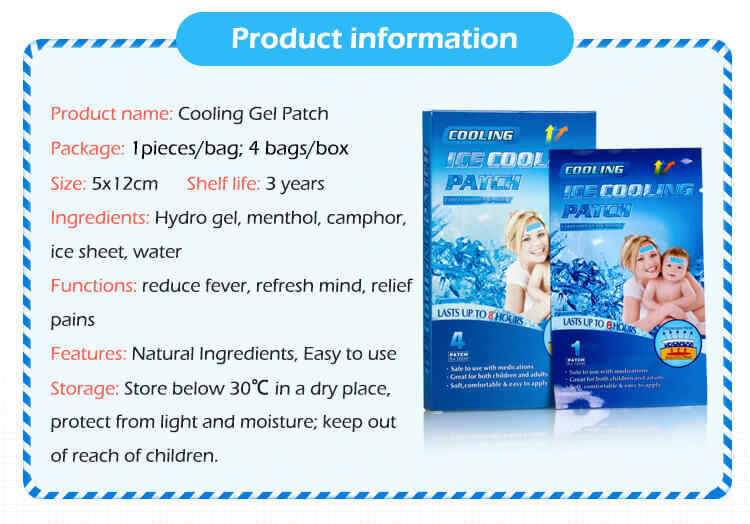Can Menthol Cooling Patches Be Made with Biodegradable Materials?
As environmental awareness grows, businesses across the healthcare and wellness industry are under increasing pressure to deliver sustainable solutions. This trend is particularly significant for menthol cooling patches, a popular product widely used for pain relief, fever reduction, and refreshing comfort. Today, many buyers, distributors, and brands want to know: Can menthol cooling patches be made with biodegradable materials?
The answer is yes—advancements in manufacturing and eco-friendly material science make it possible. However, the journey requires the right technology, investment, and collaboration with a reliable menthol cooling patches Manufacturer or menthol cooling patches Supplier. In this article, we will explore biodegradable possibilities, the role of menthol cooling patches OEM, and how Custom menthol cooling patches or Private Label menthol cooling patches can embrace eco-friendly production.

Why Sustainability Matters in Menthol Cooling Patches
The global market for cooling patches has grown rapidly, but with that growth comes environmental concerns. Traditional patches often use non-biodegradable polymers, synthetic adhesives, and plastic packaging, which contribute to waste. Consumers are increasingly eco-conscious and willing to pay more for products aligned with their values.
For a menthol cooling patches Manufacturer, sustainability is not only a responsibility but also a competitive advantage. By offering Custom menthol cooling patches with biodegradable materials, companies can appeal to eco-conscious buyers while differentiating their products in a crowded market.
What Materials Are Typically Used in Menthol Cooling Patches?
Before diving into biodegradable alternatives, it’s essential to understand what goes into a standard cooling patch:
Hydrogel Layer – Provides a cooling effect and holds menthol or herbal extracts.
Backing Layer – Often made of synthetic polymers or films that prevent leakage.
Adhesive Component – Ensures the patch sticks to the skin without irritation.
Packaging – Typically foil pouches or plastic-based wrappers for freshness.
Most of these components are not biodegradable, which raises questions about sustainability.
Can Biodegradable Materials Replace Conventional Components?
Yes, but with careful selection and testing.
Biodegradable Hydrogel Alternatives
Traditional hydrogels often rely on petroleum-based polymers.
Newer biodegradable hydrogels made from natural polymers like cellulose, chitosan, or starch are being explored.
These natural gels can deliver the same cooling effect while reducing environmental impact.
Eco-Friendly Backing Layer
Instead of synthetic films, manufacturers can use biodegradable non-woven fabrics or bio-based films.
Plant-derived materials such as PLA (polylactic acid) offer strong backing properties with compostable features.
Natural Adhesives
Many adhesives in current patches are synthetic.
However, advances in natural adhesives derived from plant resins or biopolymers are becoming viable alternatives.
Sustainable Packaging
A menthol cooling patches Supplier can provide recyclable or compostable packaging.
Paper-based packaging with biodegradable coatings can replace plastic-heavy foil packs.
Challenges in Making Biodegradable Menthol Cooling Patches
While the shift to biodegradable materials is promising, several challenges must be addressed:
Performance Balance: Eco-friendly materials must not compromise cooling duration, adhesion, or skin comfort.
Cost Considerations: Natural materials may increase production costs, which could affect pricing.
Regulatory Compliance: Any material changes must pass safety, stability, and dermatological tests.
Supply Chain Reliability: A menthol cooling patches OEM partner must ensure consistent access to biodegradable raw materials.
Despite these hurdles, many brands see sustainability as a worthwhile investment in long-term market growth.
Role of Menthol Cooling Patches OEM in Sustainability
Working with a reliable menthol cooling patches OEM partner is key for brands seeking eco-friendly solutions. OEM manufacturers typically provide:
Material Sourcing Expertise – Guidance on biodegradable polymers and natural adhesives.
Custom Formulation Options – Ability to adjust menthol concentration or add herbal extracts while keeping the patch eco-friendly.
Regulatory Knowledge – Ensuring biodegradable patches still meet international standards (FDA, CE, ISO).
Scalability – From small Custom menthol cooling patches batches to mass-market Private Label menthol cooling patches production.
Benefits of Biodegradable Menthol Cooling Patches
Shifting to eco-friendly production offers clear advantages for businesses, consumers, and the planet.
Market Differentiation – Stand out in a crowded industry by offering sustainable solutions.
Consumer Trust – Attract eco-conscious buyers who prioritize green products.
Brand Value – Enhance reputation as an environmentally responsible company.
Regulatory Advantage – Stay ahead of potential future regulations limiting single-use plastics.
Global Appeal – Many international markets now prefer products that demonstrate sustainability.
For Private Label menthol cooling patches, this is a unique selling point that can boost brand loyalty.
How Can Brands Transition Toward Biodegradable Cooling Patches?
Partner with a Trusted Manufacturer – Work with a menthol cooling patches Manufacturer that has R&D capabilities in biodegradable materials.
Start with Packaging – Switching to eco-friendly packaging is often the easiest first step.
Test New Materials Gradually – Introduce biodegradable backing or adhesives before overhauling the full patch design.
Market the Sustainability Angle – Promote eco-friendly features as a premium benefit in Custom menthol cooling patches marketing campaigns.
Leverage Private Labeling – Launch Private Label menthol cooling patches with green branding to appeal to environmentally aware consumers.
Future Outlook: The Rise of Eco-Friendly Cooling Patches
The demand for biodegradable menthol cooling patches is expected to grow alongside broader trends in sustainable healthcare and wellness products. Manufacturers who innovate early will gain an edge in international markets. OEM and private label partnerships will play a central role in making eco-friendly patches accessible, affordable, and effective.
As consumers increasingly demand products that align with their environmental values, brands that collaborate with a reliable menthol cooling patches Supplier will be well-positioned to lead the market.
Related Questions and Answers
Q1: Can biodegradable menthol cooling patches match the performance of traditional ones?
A1: Yes, with proper formulation and testing, biodegradable patches can deliver the same cooling, adhesion, and comfort while being eco-friendly.
Q2: Are biodegradable materials more expensive?
A2: Initially, costs may be higher, but economies of scale and rising consumer demand are helping to make them more competitive.
Q3: Can a menthol cooling patches OEM handle custom eco-friendly formulations?
A3: Absolutely. Many OEM manufacturers now specialize in Custom menthol cooling patches that use biodegradable gels, fabrics, and adhesives.
Q4: Do Private Label menthol cooling patches benefit from sustainability branding?
A4: Yes, eco-friendly private label products attract environmentally conscious consumers and strengthen brand loyalty.
Q5: How soon will biodegradable cooling patches dominate the market?
A5: While adoption is gradual, within the next decade biodegradable patches could become the industry standard as regulations and consumer demand evolve.






